City infrastructures are becoming increasingly complex with modernisation in population growth. Fulfilling the demands of commuters travelling long distances, especially for work, has many challenges. Bus transport planning is crucial in offering smooth and efficient traveling. Predictive analytics in transportation and artificial intelligence in smart cities help with customer-focused services. It is being implemented by more cities, helping the citizens with a tailored commute.
This article explores how AI in transportation management and predictive analytics for the transportation industry do more than enhance operational effectiveness—they help develop sustainable, passenger-focused transit solutions. We will examine real-life applications, highlight benefits, address limitations, and speculate on potential developments.
From Data to Decisions: AI’s Impact on Transportation
What does it do?
Predictive analytics for public transit makes use of machine learning techniques and statistical analysis on historical and real-time data to make informed decisions during future emergencies. Machine learning deploys techniques like data mining, time series analysis, and regression analysis. This will help you understand the factors influencing your management. With predictive analytics and AI development services, authorities can understand passengers better, improve safety, and actively anticipate and address emergencies.
To explore how advanced algorithms are implemented across industries, check out our Artificial Intelligence Services to see real-world applications beyond transportation.
The Role of AI
Artificial intelligence, especially in AI in transportation and logistics, refers to the use of algorithms that allow machines to learn from information, discern patterns, and make judgments without much human intervention. Central to AI in this industry are machine learning, natural language understanding, and computer vision that work in tandem to allow systems to digest real-time information and create actionable information. Almost 90% of all public transportation firms are actively working to create and integrate AI in public transportation into day-to-day functions, a testament to its increasing significance in the profession.
Integration with Transportation
The blending of predictive analytics and AI in transportation systems is growing more common. Transit agencies, for instance, now make use of AI algorithms to review information gathered from a number of sources for example, buses fitted with GPS tracks, traffic cameras, and ticket machines. This data-intensive practice is as much about streamlining processes as it is about having agencies dynamically adapt to shifting situations like traffic jams or unexpected delays. AI models were trialed in San Antonio, Texas, to make optimal bus route optimization as well as to predict passenger usage, making it easier to deliver services efficiently.
Is Data Necessary?
The effectiveness of predictive analytics for transportation and AI relies heavily on the quality and comprehensiveness of the data utilized. Types of data pivotal for predictive models include:
- Historical ridership data
- Real-time traffic updates
- Weather conditions
- Seasonal patterns
- Demographic information
Incorporating such varied data types allows improved resource allocation and predictive accuracy. Real-time data collection devices like sensors and GPS units are critical in aggregating information required to enable transit authorities to make efficient decisions, improve service delivery, and enhance operational efficiency in AI in bus fleet management.
Technological Infrastructure
The utility of AI in transportation market solutions depends on a strong information technology infrastructure that integrates cloud computing, IoT, and big data analytics platforms. Such advanced technologies make it possible to have huge amounts of data stored, processed, and analyzed so that information gleaned by transit authorities results in enhancing operational superiority.
Learn more about how predictive analytics and AI are shaping the future of mobility in our Transportation and Logistics Solutions.
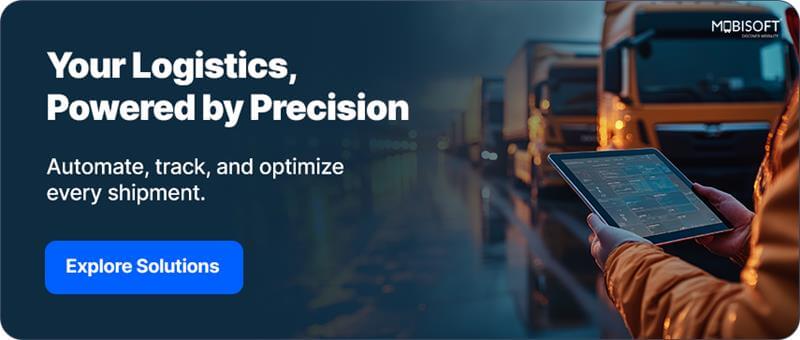
Case Studies of Successful Implementation
San Antonio, Texas
San Antonio is a leader in the use of predictive analytics for public transit to plan its public transport. By leveraging machine learning models to explore GTFS data, San Antonio has improved passenger demand planning as well as optimized bus routes. This has resulted in reduced passenger wait time and improved resource utilization, providing tangible benefits of data-driven bus planning in bus transport.
York, UK
The launch of PTV Optima has greatly optimized traffic management in York, UK. Using live data, smart transportation systems powered by AI oversee the city’s traffic. This 24/7 monitoring and analysis with the help of AI has led to easier movement and reduced vehicle emissions.
Dubai Metro
Dubai-based studies demonstrate predictive analytics for transportation industry to model metro and tram ridership. By applying machine learning methods, passenger flow seasonality is examined to give transit agencies some understanding of how passenger demand operates. These results show that predictive analytics in transportation needs to be integrated into planning processes, especially in fast-expanding cities where ridership varies substantially.
Key Points
Throughout these studies, quantifiable results repeatedly show how AI in transportation and predictive analytics in transportation benefit bus transport planning. With less time spent waiting, higher ridership, and even benefits to the environment, these technologies are proving invaluable to contemporary systems of transport.
Discover strategies to achieve greener and more efficient public transit with our sustainable transportation solutions.
Smarter Buses, Better Cities: The Upside of AI
Enhanced Operational Efficiency
One of the core advantages of incorporating predictive analytics for transportation and AI in transportation management in bus transport is the improvement of operational efficiency. AI platforms have the potential to review records of ridership against current real-time trends and consequently improve scheduling as well as resource allocation. For instance, dynamic scheduling programs can adjust bus frequencies to meet projected passenger traffic while setting resources for the most efficient utilization.
Dynamic Decision-Making
Unlike humans, AI is capable of processing vast amounts of information per second. Predictive analytics in transportation management uses this computational power to manage fleet networks. This consistent monitoring, combined with human supervision, helps prepare for possible bottlenecks such as traffic, construction, or roadblocks.
Passenger Satisfaction
With better forecasting of demands and higher reliability of services, passenger satisfaction is sure to improve. Smart predictive analytics can result in higher levels of comfort as transport authorities will be able to better align services to passenger requirements and eliminate overcrowding during rushes while keeping buses on schedule. The New York-based MTA alone serves more than two million trips daily on upwards of 300 services, showing how big a difference such efficiencies can make to commuters.
Sustainability
Route improvement through predictive analytics for transportation not only enhances efficiency but also aids in achieving sustainability goals. By reducing excess fuel consumption and emissions, AI-based transport solutions play a significant role in decreasing the environmental impact of public transport. Optimisation of routes can also result in greater use of public transport and consequently further advocate for greener urban transport systems.
Inclusivity
Predictive analytics for public transport allows public transport agencies to tailor their services to reach often underserved groups more efficiently. Through a combination of demographic data with travel behaviors, public transport agencies are better equipped to identify locations requiring more frequent services, thus enhancing mobility for public transport for all members of the community. This focus on inclusivity contributes significantly to enhanced mobility access equity across public spaces.
Environmental Benefits of AI in Bus Transportation
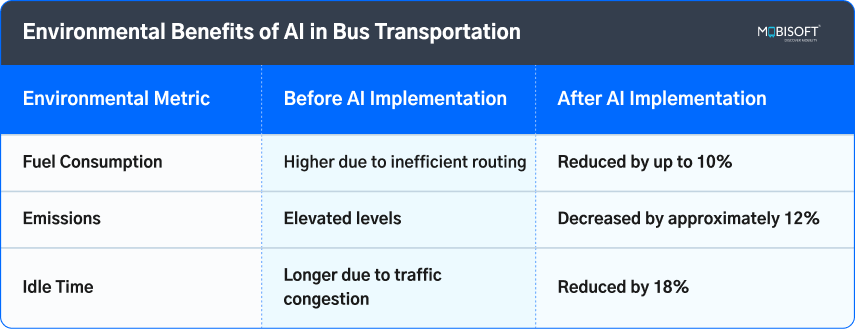
Roadblocks of Smarter Transit
Data Privacy Concerns
As more transit agencies use personal information in predictive analytics for transportation, data privacy becomes a pressing issue. With growing data breaches, it is necessary to treat personal information as sensitive, regulated and build trust among citizens.
Technology Barriers
The application of AI in transportation management and predictive analytics in transportation for bus transport planning is frequently deterred by technological constraints. For most cities, adopting such sophisticated technologies is expensive, given the required special skills. Moreover, insufficient infrastructure presents a challenge to efficient implementation, which calls for strategic planning and investment.
Dependence on Quality Data
Predictive analytics for public transit is only as good as the information fed into it. Poor data will result in poor outputs and hinder decision-making. Transit agencies must invest in robust collection instruments and systems to provide access to reliable information for data-driven bus planning.
Integration with Legacy Systems
Transit agencies are old, without AI integration for bus fleet management. Integration of AI systems with legacy systems is a time-consuming and expensive task that needs specialization. The cities of Chicago and Los Angeles have had a difficult time incorporating AI solutions within their transport infrastructure, which points out the necessity of planning strategically when introducing AI within transport and logistics infrastructure.
Real-time data is key to operational success find out more about real-time vehicle tracking and its impact on fleet efficiency.
Future Trends in Bus Transportation Planning
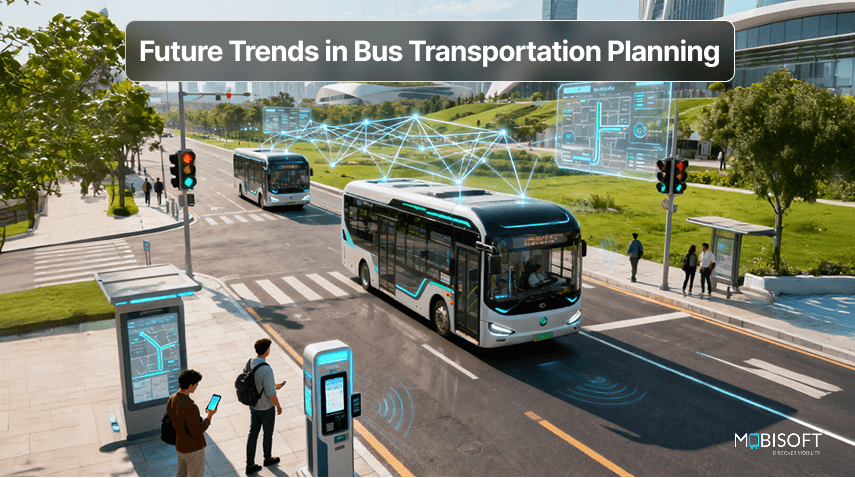
Emerging Technologies
The bus transport planning of the future will be revolutionized by new technologies such as sophisticated AI use in transportation, machine learning, and driverless vehicles. These will improve the capacity of predictive analytics for transportation, so that transit agencies will be able to develop forecasts and make choices even more precisely.
Integration of Autonomous Vehicles
Incorporating self-operating buses into mass transit systems presents a world of promising opportunities. As technological developments in artificial intelligence in smart cities keep moving forward, the prospect of such driverless vehicles coexisting with older models of transit might revamp city mobility, most likely leading to improved efficiency and reduced operational expenditures.
Smart City Initiatives
As cities increasingly adopt smart technology, the role of smart transportation systems and AI in public transportation in creating integrated systems of mobility will only expand further. Smart city efforts that incorporate predictive analytics in transportation management can enable one-step mobility services, enable better communications among services in real time, and promote information sharing among numerous agencies.
Public Engagement
Community engagement in transport planning is of crucial significance. By obtaining information from commuters and examining this input through predictive analytics for public transit, transport authorities can devise services that are suitable for the commuters.
AI-Driven Impact on Bus Transit Operations (2025)
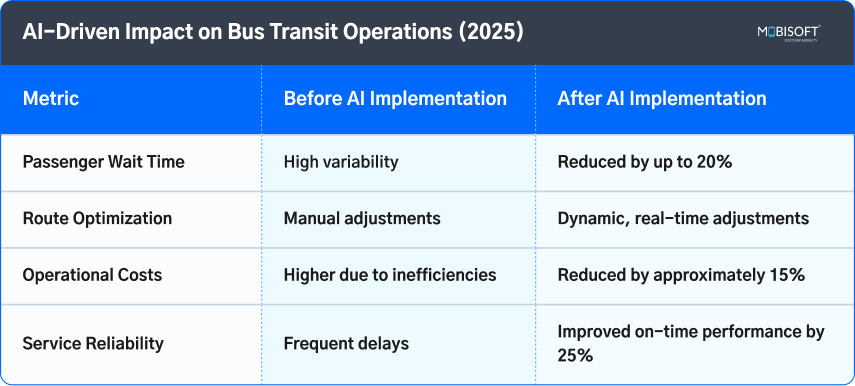
Toward Smarter, Fairer, and Greener Bus Systems
Predictive analytics and AI in transportation make of data, helping commuters with a easier, faster travel experience. These are not futuristic technologies, they are being implemented as of today. These buses adjust routes based on real-time data, travel to exact point of location, and even predict probable issues in commuter’s travel.
The result? Operators realize higher efficiency, passengers enjoy less time spent waiting around, and cities move closer to sustainability aims through reduced emissions and waste. Yet it is technology alone that cannot bring about this transformation. Actual progress is achieved when transit agencies, civic officials, and tech innovators work together, pooling their knowledge and promising ongoing enhancements.
As cities expand and populations change, it is those publicly served systems that will thrive that adopt such innovations. This is an assurance of safe and accessible mobility to all, day in and day out. With a collaborative vision and a long-term perspective, predictive analytics in transportation and AI use in transportation can actually make public transport function as the core of a lively and accessible city.
A strong IT backbone is essential for bus operations. Learn how modern transportation management systems support AI-driven planning and operational efficiency.
Key Takeaways:
- Artificial intelligence and predictive analytics aoffer higher efficiency, personalisation, and are reliable because of real-time data. Thusre transforming bus transport across cities.
- Integrating these technologies requires high-quality real-time information from historical ridership, traffic, weather, and demographic patterns.
- Strong IT infrastructure, including cloud computing, IoT, and big data platforms, is essential for processing data and supporting AI-driven decision-making.
- San Antonio, York, and Dubai case studies show tangible improvements such as lower wait times, better routing efficiency, better utilization of resources, and lower emissions.
- Artificial intelligence can alter schedules and optimize routes based on data. This helps in achieving optimized operation efficiency.
- Predictive analytics provides adaptive decision-making through traffic flow monitoring, construction activities, and other potential bottlenecks to facilitate continuous operation effectiveness.
- When services are more reliable, comfortable, and matched to immediate demand, passenger satisfaction is improved even more so when traffic is heavy.
- Route optimization by AI results in fuel saving as well as emissions saving and encourages wider utilization of public transport.
- Inclusivity is improved as transport authorities can identify underserved neighborhoods and tailor services to reach more citizens.
- Challenges include data privacy issues, technological challenges, dependence on high-quality information, and integration requirements with legacy systems, which present careful planning and heavy investment.
- The trends of the future look to advanced AI, self-driving buses, and integrated smart cities to improve predictive planning and build more linked and responsive cities' transport systems.
- Cooperation between civic government entities, transit agencies, and tech entrepreneurs is necessary to realize the potential of predictive analytics and AI in transportation in cities.
FAQs
Q1: In what ways does predictive analytics improve real-time optimal routing of city bus networks?
A: With the help of Predictive analytics in transportation, teams can locate passengers, analyse where they will be, and re-route based on congestion on the road ahead. Buses no longer need to stick to fixed timetables but can adjust to real situations, resulting in fewer delays and higher reliability for passengers.
Q2: What are the most efficient types of artificial intelligence algorithms in passenger demand and traffic prediction?
A: Algorithms that integrate machine learning with pattern recognition techniques, such as time series analysis or neural networks, generally perform best. These systems can process large quantities of historical and real-time data to identify nuanced trends, supporting AI use in transportation.
Q3: How do transit agencies balance data privacy considerations with real-time predictive information needs?
A: Agencies achieve this by anonymizing passenger information and focusing on aggregate trends rather than individual behaviors. This approach allows for effective predictive analytics for public transit while maintaining trust and improving service planning and responsiveness.
Q4: What are the infrastructural needs of AI-enabled bus-based mass transport systems in emerging cities?
A: A robust IT backbone is required, including cloud platforms, IoT-powered sensors, and big data analytics platforms. These systems support AI in transportation management and enable real-time collection, processing, and analysis of large amounts of data for AI-driven decision-making.
Q5: In what ways can traditional transport systems be combined with new artificial intelligence and predictive analytics technologies?
A: Integration typically follows a sequential strategy, progressively incorporating predictive analytics and AI in transportation into legacy systems. Middleware or data connectors allow older technologies to interact with predictive platforms, enabling cities to capitalize on AI in public transportation without a full infrastructure redesign.
Q6: What concrete benefits have cities like San Antonio and York realized after introducing AI into bus planning?
A: These cities have achieved improved bus services, reduced waiting times, and better alignment of services with passenger needs through predictive analytics in transportation and bus route optimization.
Q7: In what ways can predictive analytics aid in sustainability and reduce emissions in city buses?
A: Improved scheduling and timetabling using transport predictive analytics saves downtime and wasted fuel. Increased ridership and effectiveness decrease pollution and make environmentally friendly urban transport feasible.
Q8: In what ways can artificial intelligence facilitate access to buses by disadvantaged groups?
A: Artificial intelligence in smart cities has the exceptional capability of identifying underserved locations or locations with high travel time, thus enabling agencies to spatially distribute resources more fairly. This ensures that all communities, even the previously neglected ones, have easy accessibility to public transport buses.
Q9: What are the main disadvantages or risks of relying on AI and predictive analytics in subway planning?
A: Poor-quality data means poor-quality predictions; investments are high upfront, and new technologies may struggle to integrate with what currently exists on the ground. A lean reliance on automation, without human diligence, creates the risk of blind spots at AI-driven transport decision-taking points.
Q10: How will predictive analytics and city transport efficiency be affected by autonomous buses?
A: Predictive analytics and AI development services allow Autonomous buses to gather precise data. It can reroute using this data to shorten the travel time and even reschedule. The use of AI in transportation and added human monitoring results in smoother rides, fewer delays, and much better reliability.


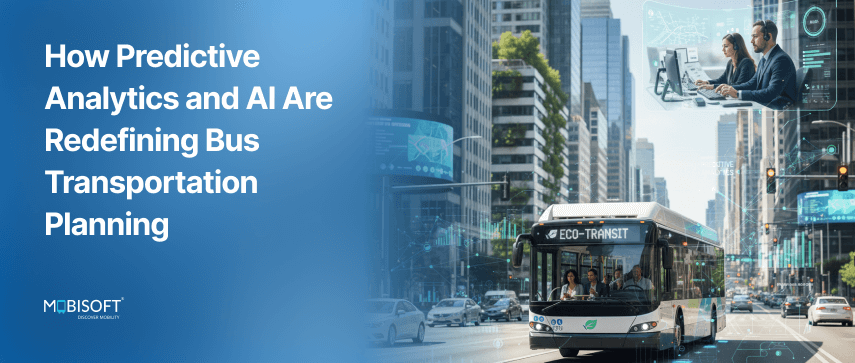


 September 9, 2025
September 9, 2025


